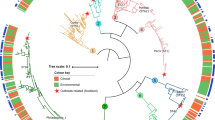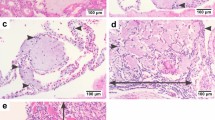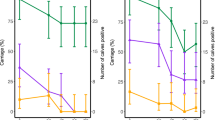Abstract
Detection and monitoring of genetically engineered microorganisms released to the environment, as well as pathogens, are primary factors in risk assessment. Culture methods have been proposed for both detection and monitoring. However, microorganisms in natural systems may not always be culturable. We surveyed environmental samples collected from sources implicated in an epidemic of Legionnaires' disease and, although no cultures were recovered from environmental samples, numerous cells were observed by fluorescent microscopy when anti–L. pneumophila group 1 antibody was used. Similar observations have often been made by others. To study this loss of culturability, L. pneumophila strains were maintained in a microcosm (vessels containing sterilized environmental water) and assayed at intervals for growth on appropriate media, and lethality for chick embryos. At 4°C, the decimal rate of decline of colony forming cells was approximately 29 days; at 37°C it was 13 days. When microcosm water samples were injected into embryonated eggs, far greater chick embryo mortality was observed than could be accounted for by the number of culturable cells in the injections. Thus, previously non–culturable Legionella had multiplied once again and become culturable. These results indicate that samples that do not contain culturable cells, may contain cells that are viable, as demonstrated by their pathogenicity for chick embryos. The fluorescent antibody assay may provide a valuable indication of the presence of such viable but non–culturable cells.
This is a preview of subscription content, access via your institution
Access options
Subscribe to this journal
Receive 12 print issues and online access
$209.00 per year
only $17.42 per issue
Buy this article
- Purchase on Springer Link
- Instant access to full article PDF
Prices may be subject to local taxes which are calculated during checkout
Similar content being viewed by others
References
Tison, D.L. and Seidler, R.J. 1983. Legionella incidence and density in potable drinking water supplies. Appl. Environ. Microbiol. 45: 337–339.
Fliermans, C.B., Cherry, W.B., Orrison, L.H., Smith, S.J., Tison, D.L., and Pope, D.H. 1981. Ecological distribution of Legionella pneumophila . Appl. Environ. Microbiol. 41: 9–16.
Fliermans, C.B., Thacker, W.B., Orrison, L.H., and Thacker, L. 1979. Isolation of Legionella pneumophila from nonepidemiologic-related habitats. Appl. Environ. Microbiol. 37: 1239–1242.
Edelstein, P.H. 1982. Comparative study of selective media for isolation of Legionella pneumophila from potable water. J. Clin. Microbiol. 16: 697–699.
Fitzgeorge, R.B. and Dennis, P.J. 1983. Isolation of Legionella pneumophila from water supplies: Comparison of methods based on the guinea-pig and culture media. J. Hyg., Camb. 91: 179–187.
Tobin, J.O'H., Swann, R.A. and Bartlett, C.L.R. 1981. Isolation of Legionella pneumophila from water systems: methods and preliminary results. Brit. Med. J. 282: 515–517.
McDade, J.E. and Shepard, C.C. 1979. Virulent to avirulent conversion of legionnaire's disease bacterium (Legionella pneumophila)—Its effect on isolation techniques. J. Inf. Dis. 139: 707–711.
Brown, A., Vickers, R.M., Elder, E.M., Lema, M., and Garrity, G.M. 1982. Plasmid and surface antigen markers of endemic and epidemic Legionella pneumophila strains. J. Clin. Microbiol. 16: 230–235.
Para, M.F., Plouffe, J.F., and Maher, W.E. 1984. Production of monoclonal antibodies to Legionella pneumophila and relationship of monoclonal binding to plasmid content, p. 262–264. In: C. Thorns-berry, A. Balows, J. C. Feeley, and W. Jakubowsky (eds.), Legionella: Proceedings of the 2nd international symposium. American Society for Microbiology, Washington, D.C.
Bollin, G.E., Plouffe, J.F., Para, M.F., and Prior, R.B. 1985. Difference in virulence of environmental isolate of Legionella pneumophila . J. Clin. Microbiol. 21: 674–677.
Kuchta, J.M., States, S.J., McGlaughlin, J.E., Overmeyer, J.H., Wadowsky, R.M., McNamara, A.M., Wolford, R.S., and Yee, R.B. 1985. Enhanced chlorine resistance of tap water-adapted Legionella pneumophila as compared with agar-medium passaged strains. Appl. Environ. Microbiol. 50: 21–26.
Elliot, J.A. and Johnson, W. 1982. Virulence conversion of Legionella pneumophila serogroup 1 by passage in guinea pigs and embryonated eggs. Infect. Immun. 35: 943–946.
Cherry, W.B. and McKinney, R.M. 1979. Detection of Legionnaires' disease bacteria in clinical specimens by direct immunofluorescence, p. 92–103. In: G. L. Jones and G. A. Hebert (eds.), Legionnaires': The disease, the bacterium and the methodology. U.S. Department of Health, Education and Welfare, CDC, Atlanta, Ga.
Colwell, R.R., Brayton, P.R., Grimes, D.J., Roszak, D.B., Huq, S.A., and Palmer, L.M. 1985. Viable but non-culturable Vibrio cholerae and related pathogens in the environment: Implications for the release of genetically engineered microorganisms. Bio/Technology 3: 817–820.
Hobbie, J.E., Daley, R., and Jasper, S. 1977. Use of Nuclepore filters for counting bacteria by fluorescent microscopy. Appl. Environ. Microbiol. 33: 1225–1228.
Joly, J.R., Chen, Y., and Ramsey, D. 1983. Serogrouping and subtyping of Legionella pneumophila with monoclonal antibodies. J. Clin. Microbiol. 18: 1040–1046.
Watkins, I.D. and Tobin, J. O'H. 1984. Studies with monoclonal antibodies to Legionella species, p. 259–262. In: C. Thornsberry, A. Balows, J. C. Feeley, and W. Jakubowsky (ed.), Legionella: Proceedings of the 2nd international symposium. American Society for Microbiology, Washington, D.C.
Kogure, K., Simidu, U., and Taga, N. 1979. A tentative direct microscopic method for counting living marine bacteria. Can. J. Microbiol. 25: 415–420.
Feeley, J.C., Gibson, R.J., Gorman, G.W., Langford, N.C., Rasheed, J.K., Mackel, D.C., and Baine, W.B. 1979. Charcoal-yeast extract agar: Primary isolation medium for Legionella pneumophila . J. Clin. Microbiol. 10: 437–441.
England, A.C., Fraser, D.W., Mallison, G.F., Mackel, D.C., Skaliy, P., and Gorman, G.W. 1982. Failure to predict culture results from disinfectant-treated air-conditioning cooling towers. Appl. Environ. Microbiol. 43: 240–244.
Xu, H.S., Roberts, N., Singleton, F.L., Atwell, R.W., Grimes, D.J., and Colwell, R.R. 1982. Survival and viability of nonculturable Escherichia coli and Vibrio cholerae in estuarine and marine environments. Microb. Ecol. 8: 313–323.
Rollins, D.M. and Colwell, R.R. 1986. Viable but nonculturable stage of Campylobacter jejuni and its role in survival in the natural aquatic environment. Appl. Env. Microbiol. 52: 531–538.
Tenover, F.C., Edelstein, P.H., Goldstein, L.C., Sturge, J.C., and Plorde, J.J. 1986. Comparison of cross-staining reactions by Pseudomonas spp. and fluorescein-labeled polyclonal and monoclonal antibodies directed against Legionella pneumophila . J. Clin. Microbiol. 23: 647–649.
Westfall, H.N., Myers, W.F., and Weiss, E. 1982. Detection of Legionella antibodies by enzyme-linked immunosorbent assay (ELISA) using whole cell and carbohydrate antigens. Microb. Ecol. 8: 287–298.
Weiss, E. and Westfall, H.N. 1984. Substrate utilization by Legionella cells after cryopreservation in phosphate buffer. Appl. Environ. Microbiol. 48: 380–385.
Cherry, W.B., Pittman, W.B., Harris, P.P., Hebert, G.A., Thomason, B.M., Thacker, L., and Weaver, R.E. 1978. Detection of Legionnaires' Disease Bacteria by direct immunofluorescent staining. J. Clin. Microbiol. 8: 329–338.
Author information
Authors and Affiliations
Rights and permissions
About this article
Cite this article
Hussong, D., Colwell, R., O'Brien, M. et al. Viable Legionella pneumophila Not Detectable by Culture on Agar Media. Nat Biotechnol 5, 947–950 (1987). https://doi.org/10.1038/nbt0987-947
Received:
Accepted:
Issue Date:
DOI: https://doi.org/10.1038/nbt0987-947
This article is cited by
-
Comparative analysis of solar pasteurization versus solar disinfection for the treatment of harvested rainwater
BMC Microbiology (2016)
-
Free-living amoebae and their associated bacteria in Austrian cooling towers: a 1-year routine screening
Parasitology Research (2016)
-
Comparing methods of determining Legionella spp. in complex water matrices
BMC Microbiology (2015)
-
Influence of copper surfaces on biofilm formation by Legionella pneumophila in potable water
BioMetals (2015)
-
Viable but Not Culturable Forms of Legionella pneumophila Generated After Heat Shock Treatment Are Infectious for Macrophage-Like and Alveolar Epithelial Cells After Resuscitation on Acanthamoeba polyphaga
Microbial Ecology (2015)



